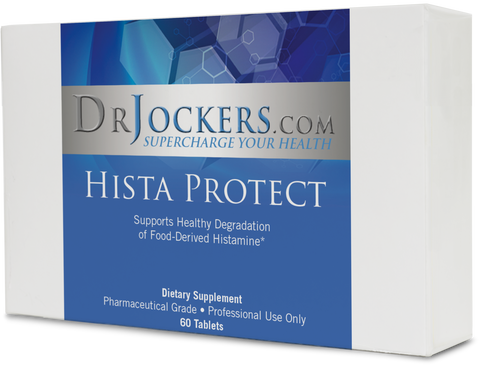
Hista Protect contains a multi-patented, gastro-resistant source of DAO provided at an easy-to-swallow mini-tablet containing a clinically researched dose of 20,000 HDU.- Dr. Jockers
Read our customer reviews and you'll see why our clients agree these are...
Supplements You Can
TRUST
Hista Protect

What is Hista Protect?
Hista Protect™ is a patented enzyme formula containing diamine oxidase (DAO)—the main enzyme responsible for the degradation of ingested histamine.
This enzyme has been clinically tested and found to break down food-derived histamine in the digestive tract. DAO is not absorbed and does not have systemic activity. Hista Protect does not manage or address antibody-related or IgE-related food allergies.*

What is Histamine?
Histamine is an important neurotransmitter and immune messenger molecule. It is involved in processes involving hydrochloric acid secretion for digestion, triaging water reserves to key areas of the body, and the inflammatory response (1).
One of the major effects of histamine is causing the blood vessels to swell and dilate. When the body senses that it is threatened it will secrete higher amounts of histamine. This allows the white blood cells to quickly move through the bloodstream and find the potential threat or infection. This is an important component of a healthy immune response.

Where are Histamine Receptors?
Histamine receptors are located all over the body and have many important functions including:
Histamine H1 receptors: Smooth muscle and endothelial cells affecting skin; blood vessels (Benadryl and Claritin block activity of these receptors)
Histamine H2 receptors: Cells in the intestines control acid secretion, abdominal pain, and nausea; heart rate
Histamine H3 receptors: Central nervous system controlling nerves, sleep, appetite, and behavior
Histamine H4 receptors: Thymus, small intestine, spleen, colon, bone marrow, and white blood cells; inflammatory response
One of the major effects of histamine is causing the blood vessels to swell and dilate. When the body senses that it is threatened it will secrete higher amounts of histamine. This allows the white blood cells to quickly move through the bloodstream and find the potential threat or infection. This is an important component of a healthy immune response.

When Does Histamine Become a Problem?
Histamine only becomes a problem when we have metabolic disturbances that do not allow us to effectively metabolize histamine properly. When histamine is formed it is broken down by specific enzymes. In the central nervous system, it is metabolized by histamine N-methyltransferase (HMT), while in the digestive tract, it is broken down by diamine oxidase (DAO).
The experts state that DAO is the major enzyme involved in histamine metabolism (2). The enzyme converts the histamine into imidazole acetaldehyde which does not trigger any sort of reaction in the body. DAO is responsible for ensuring a steady histamine level required for the balance of numerous chemical reactions taking place in the body.
Some individuals have altered DAO production due to several different factors including (3):

Who Has Histamine Intolerance?
According to available research, histamine intolerance manifests in approximately 3% of the population (6). In up to 20% of these cases, the symptoms occur mostly when histamine-containing foods are used in combination with DAO inhibitors such as alcohol. Approximately 80% of individuals with histamine intolerance are women and most of them are over 40 (7).
The three biggest factors involved with histamine intolerance include leaky gut syndrome, irritable bowel, gluten sensitivity, etc. (8). The second factor is a genetic polymorphism with the DAO enzyme. Heavy alcohol and/or medication usage is another strong risk factor.
Common Symptoms of Histamine Intolerance Include (9, 10):

Histamines travel throughout the bloodstream and therefore can affect the gut, lungs, skin, brain, and entire cardiovascular system. This is why there is such a wide array of health problems associated with it and it is quite challenging to pinpoint and diagnose if you are not aware of the condition.

DAO Enzymes:
DAO (Diamine Oxidase) is the major enzyme involved in histamine metabolism (11). Its responsibility is to convert histamine into imidazole acetaldehyde. This is a safe reaction that does not trigger any irritation or inflame any region of the body.
DAO’s job is to ensure a steady histamine level required for the balance of the numerous chemical reactions it is needed for without allowing it to accumulate in high amounts. As stated above, many individuals have deficiencies in DAO enzymes and therefore suffer from histamine reactions.
Hista Protect is the best DAO enzyme I have found because it has a high potency DAO enzyme with 20,000 HDU for a huge impact to enhance the histamine-reducing effect.
When does Dr. Jockers recommend Hista Protect?
As a clinician, I frequently order blood work when I suspect a histamine intolerance. If the results show a histamine intolerance, I place the individual on a low-histamine diet and have them take DAO enzymes until we can get the underlying cause (leaky gut most often) under control.
DAO enzymes can be a lifesaver for someone with a moderate to severe histamine intolerance and can be a helpful tool for someone with a milder histamine intolerance.
For individuals who don’t want to get the blood test done, I recommend they start with a low-histamine diet and a trial run with DAO enzymes and see if they notice a difference. If so, they most likely have a histamine intolerance and should remain on the diet while they fix the underlying problems.
What is the recommended dosage?
Take one tablet no more than 15 minutes before the consumption of histamine-rich foods, or take it as directed by your healthcare professional.
CAUTIONS: Consult your healthcare practitioner before use, especially if you are pregnant or nursing. Keep out of reach of children. Avoid if allergic to pork or any other ingredient.
Hista Protect™ is NOT EFFECTIVE for symptoms of immune-related food allergies, such as peanuts, shellfish, etc., or for gluten intolerance due to sensitivity or celiac disease.
DOES NOT CONTAIN: Wheat, gluten, corn, yeast, soy, dairy products, fish, shellfish, peanuts, tree nuts, eggs, sesame, ingredients derived from genetically modified organisms (GMOs), artificial colors, and artificial sweeteners.
STORAGE: Keep tightly closed in a cool, dry place.

Select Your Options & Add to Cart
† These statements have not been evaluated by the Food and Drug Administration.
This product is not intended to diagnose, treat, cure or prevent any disease.





